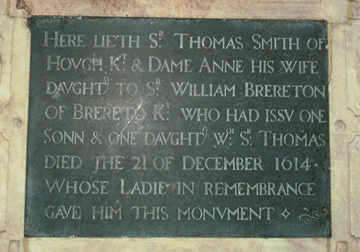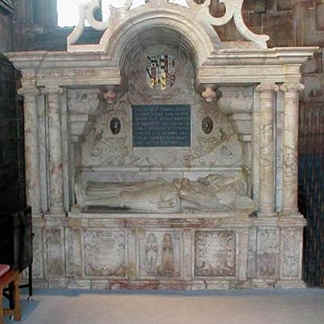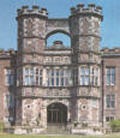|
Harold Forster M.B.E.
To the Worldwide Brereton Family Reunion
St. Mary’s Church, Nantwich, Cheshire
31 July 2001
Once again, let me repeat for the record what the Rector said:
it’s a joy to have you, because we love sharing this place
with as many people as possible. In a way, I suppose, there is a
connection between this town, this church, and the Brereton family
of Cheshire, for both owe something to the event that took place
on the 14th of October, 1066, when the invading Norman
army led by William defeated the Saxon King Harold at Senlac, in
Sussex. I always feel sorry for that, because they christened me
Harold too.
To subdue the unruly Saxons, in the north of what was now his realm,
William appointed, very wisely, his nephew Hugh Lupus, to be the
Norman Earl of Chester. And he in turn appointed eight barons to
take up residence in parts of the area now under his control. One
of these, William Malbank, came to Nantwich, here to build his castle
and to rule the town and the surrounding countryside, developing
the salt-producing town of Nantwich in the process. He also built
a church in the town.
It seems very likely that there was a Brereton – or Breton,
as then known – amongst that victorious Norman force. And maybe
it was in honor of the leader of that invasion, William of Normandy,
that so many of the subsequent male members of the Brereton family
were christened William – a fact that has caused so much confusion
to historians.
It is recorded that the manor of Brereton was held under the Baron
of Kinderton, another of the barons appointed by Earl William –
held by the Brereton family from shortly after the Norman Conquest
until 1722, when the last Lord Brereton died. So for almost 700
years, the Breretons were an important family in this area.
And as an indication of how they spread across the Cheshire plain,
there are Brereton monuments or memorial tablets in a number of
churches, including Astbury, Bowdon, Brereton, Harthill, Mobberley,
Shocklach, and of course, here in Nantwich, as well as Brereton
chancelry chapels in the churches at Malpas and Cheadle. Additionally,
there are of course the ancestral homes, especially perhaps, the
ones at Brereton and Handforth.
It’s interesting to note that, when in 1571, Sir William Brereton
married the daughter of John Savage, he rebuilt the ancestral home
at Brereton after the style of the Rock Savage home at Runcorn,
the home of his bride, and that in the construction of the home
at Brereton, he used bricks instead of the then-customary timber
frame – probably the first brick-built house in Cheshire.
So, in the history books of Cheshire, we read of the Breretons
of Brereton, the Breretons of Malpas, the Breretons of Tatton, the
Breretons of Aldford, the Breretons of Ashley, the Breretons of
Handforth. They really got around.
And it’s from the latter branch of the family that came Sir
William Brereton, baronet, General of the Parliamentary forces in
the Civil War, and he was heavily involved with the defense of this
town of Nantwich. And it is probably this member of the family that
had the closest links with this town.
So what of him? The first mention of this well-known member of
the Brereton family appears in the register of christenings at Manchester
Collegiate Church, now Manchester Cathedral, for 1604, with the
entry "William, son of William Brereton of Handforth."
When only six years of age, William’s father died, but he
developed into a worthy descendant of the many illustrious ancestors
he had, receiving his education at Brasenose College, Oxford. In
1627, when he was only 23 years of age, he was created a baron by
King Charles I, the monarch he was later to so vigorously oppose
in armed conflict.
In 1628, he was elected Member of Parliament for Cheshire, but
he relinquished his seat in order to travel. And his grand tour
took him to Scotland, Ireland and Holland. Whilst in Holland, he
took a great interest in military matters, being especially intrigued
with the art of siege warfare – an interest that was to serve
him well in later days.
In 1639, he was re-elected as a Member of Parliament and came under
the notice of several leading politicians who looked upon him as
a born leader.
He married twice. His first wife, Susannah, the daughter of Sir
George Booth of Dunham Massey, in Cheshire, died in 1637, leaving
one son, Thomas. Sir William’s second wife was Cecily, the
daughter of Sir William Skeffington of Leicestershire. She was the
widow of Edward Mytton of Weston in Staffordshire. William
and Cecily had two daughters.
Well, Sir William had very decided views on what was called the
"Divine Right of Kings." And he objected very strongly
to certain tax demands – there’s nothing new – especially
the so-called ship tax. He was also in continuous dispute with the
Mayor and Corporation of the City of Chester for refusing to pay
the murage tax, a tax levied on all property owners in that city
for the repair and maintenance of its walls. He owned a town house
in Chester.
And when in 1642, Charles raised his standard at Nottingham, declaring
the Civil War, Sir William was in Chester, trying to drum up support
for the Parliamentary army. For this, he was chased out of the city
by the city fathers – an action that they were later to regret.
As the Civil War spread across the county, Sir William was given
command of the Parliamentary forces being mustered in Cheshire,
and later he was appointed Major General of Cheshire, Shropshire,
Lancashire and Staffordshire. His strong point was not so
much as a leader in the field but in the plans he initiated to obtain
information about enemy movements, and of course, in seige warfare,
gained from the knowledge he obtained during his visit to Holland.
It was said that Brereton "had spies under every hedge and
friends in every village."
His greatest triumph was his seige and capture of the city of Chester,
a project that took over 12 months.
In 1643, he came to this town of Nantwich, arriving just ahead
of a Royalist army led by Sir Thomas Aston. The town was considered
very important by both sides because of the road system. The road
at that time going through Nantwich was the main road from London
to North Wales and Ireland. Making the town their headquarters,
the leaders of the Parliamentary forces quickly surrounded the place
with earthworks and trenches sufficient to keep out the assault
of the Royalist army, now encamped in the surrounding area.
The town was under siege from December 1643 until January 1644,
but in the Battle of Nantwich, on the 25th of January
1644, the Royalist army under Lord Byron was soundly defeated by
the Parliamentary forces under Sir Thomas Fairfax.
After the war, Sir William Brereton was well rewarded for his efforts.
Among other gifts, he received the Chief Forestership – that
means he was the boss of the forest - at Macclesfield, and also
the Seneschalship of the Hundred at Macclesfield, both of which
would provide him with considerable monetary benefits.
In 1652, he was given the tenancy of Croydon Palace, the former
home of the Archbishop of Canterbury. He spent the last nine years
of his life commuting between his newly acquired London home and
his ancestral home at Handforth, in Cheshire.
He died at Croydon in 1661. The story is told of how the body,
when being brought back to Cheadle for burial, when crossing the
river, was lost. But it is now generally assumed that it did reach
Cheadle, and that he was buried in the family vault in that Cheshire
town church.
In the Civil War, the church here at Nantwich was for a period
used as a prison for captured Royalist troops. But the memorial
in this church is to a Smith - the Smith Memorial, now in this church.

Photo by the editor.
Well, Sir Thomas Smith was Lord of the Manor at Hough, nearby,
and the owner of considerable lands in this area. He was Mayor of
Chester in 1596, and Sheriff of that city in 1614. He married Anne,
daughter of Sir William Brereton of Brereton. He died in 1614 and
was laid to rest in the next parish at Wybunbury, where his wife
Anne provided a magnificent canopied monument with figures of Sir
Thomas, of his wife, together with those of their son and daughter,
represented as weepers. But it’s interesting to note that the
son had got a beard.

Photo courtesy of The
Sealed Knot.
In 1978, Wybunbury church was demolished because it was unsafe,
and the tomb was dismantled and placed in store, where it suffered
some damage. Later, after restoration, it was re-erected in the
south transept of this church of St. Mary, here at Nantwich.
The Sir William Brereton who held Nantwich for the Parliamentary
forces during the war was a relative of Dame Anne.
There is a story that after the Battle of Nantwich, Sir William
Brereton, the supporter of the Parliamentary cause, organized a
siege of Brereton Hall, the home of his Royalist relative, whose
young son allegedly scratched on a window pane
"On yonder hill my uncle stands,
but he will not come near,
for he is a Roundhead,
and I am a Cavalier."
The four unmarried daughters of this Lord Brereton, the victim
of his relative’s military activity, came to live in Nantwich,
and here they died – Frances in 1712, Mary in 1716, Anne in
1719, and Jane in 1720. Now, they are buried in the Wilbraham vault,
under the south transept, where now stands the Smith memorial.
From Cheshire, where they made their home in the eleventh century,
the Breretons have spread all over the world, many of them, no doubt,
achieving fame and renown, relying at all times on the Brereton
motto, "Opitulante Deo," - "God Being My
Helper."
Thank you.
Transcribed and edited by Thomas F. Brereton, San Antonio, Texas
(t.brereton@sbcglobal.net)
|
|
|

